What is the Kangarena?*

The Kangarena is a traditional Australian dance, first performed in Australian aboriginal ceremonies and now adapted for, and adopted by, the wider Australian population as the Australian national dance. As Australians are not noted for their dancing skills the Kangarena is not performed as regularly as one would expect of a national dance. e.g. the flamenco in Spain, the tango in Argentine, the Irish jig in Ireland, the limbo in Trinidad & Tobago and of course the polka of Lichtenstein, however in recent times it has gained in popularity and becoming more widely recognised.
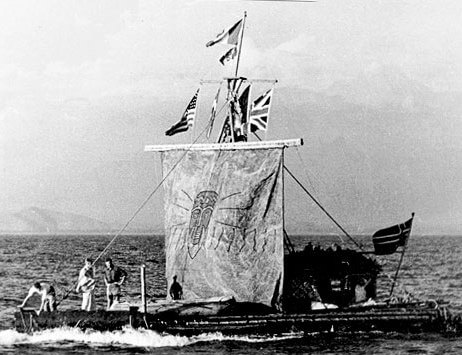
The origins of the Kangarena are lost in the mists of time, but it is thought to have been performed by Australian aboriginals for many centuries prior to 18th Century European settlement. As the dance has some resemblance to the Spanish Macarena it has been speculated that there is a cultural link between aboriginal settlement in Australia and the Spanish people. Indeed, it has been said that the late Norwegian explorer and ethnographer Thor Heyerdahl, having proven the link between South American and Polynesian cultures (Kon-Tiki expedition 1947) and also the North African and West Indian populations (Ra and Ra II, 1969 & 1970); was planning a third trip on a traditional Spanish trading boat to prove the link between the Spanish and Australian aboriginal culture.
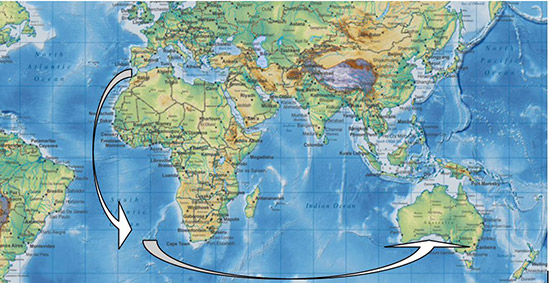
The theory postulated was that a group of Spanish men and women departed Spain to cross the Straits of Gibraltar on a trip to deliver a cargo of rice and chickens to Morocco. They were also carrying a gift for the Moroccan leader in the form of a box of saffron. A large storm swept them into the Atlantic and then carried far south. Currents conspired to propel the craft around the Cape of Good Hope and eastwards to the shores of Australia where a settlement was established.
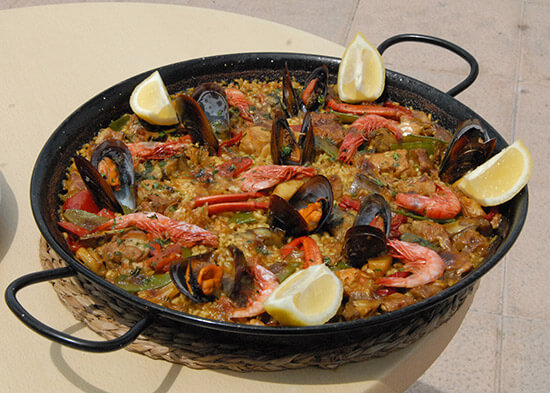
Fortunately, with the rice and chickens, plus the fish they caught on the way they were able to survive on paella for the length of the trip. The saffron was also used to colour and flavour the paella. Over the years the Spaniards integrated with the Australian indigenous community and whilst the art of making paella was lost, the Macarena was adapted to Australian conditions, hence the Kangarena was born.

The purpose and importance of dance in the Australia aboriginal culture
The Australian aborigines do not have a written language; hence their knowledge was recorded in a range of forms: song, dance, story and memory devices. Each had their own significance and level of importance. Songs are more important than dances, but dances were important too. The traditional corroboree were massive gatherings open to all and included dance, plus other ways to convey aspects of knowledge and culture.
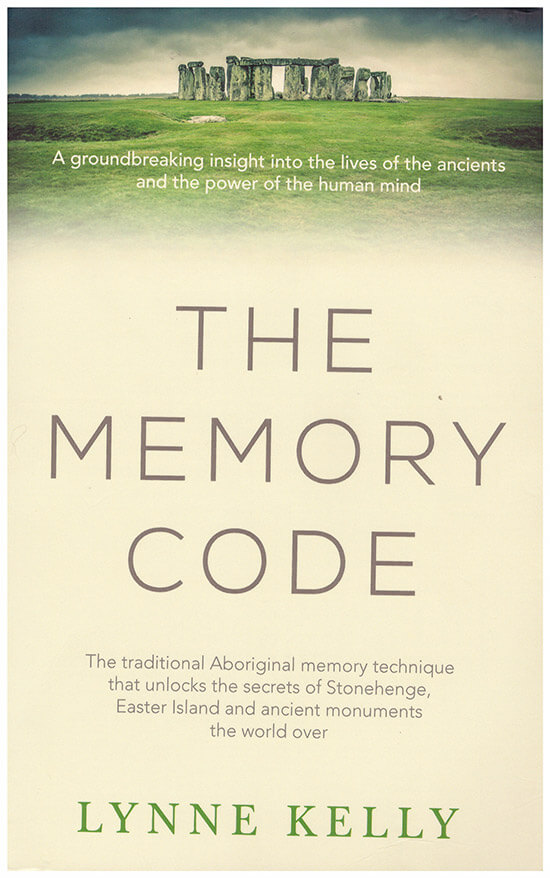
Associated events, such as boras, were restricted to those who were higher up the social standing and contained more important impormation. With the additional aid of memory devices and songlines as described in The Memory Code by author Dr Lynne Kelly, these were amazingly robust ways of ensuring important information could be passed from one generation to the next – and the next – and so on down the centuries. The corroboree, dance, song, storylines and boras summed to kind of encyclopaedia for those with no written language who needed detailed and accurate information about their environment to survive. The dance was used to describe where to find water in times of drought; it acted as the map for these mobile aboriginal people.
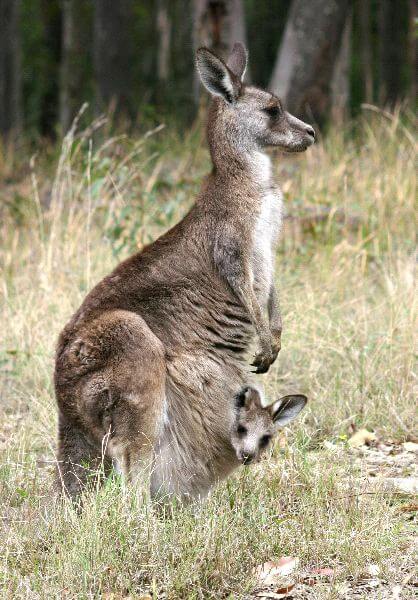
Groups moved between a series of semi-permanent sites. The frequency of movement depended on the environment and specific culture, of which there were over 300 language groups. The dance mimicked animal movements and it recorded how to best hunt animals, plus preserved other important spiritual information. Whilst corroborees are quite secret and not accessible to the non-indigenous population, because of the Spanish/European influence of the Kangarena an exception has been made for this multicultural dance.
It should be noted that the kangaroo was a significant source of protein (meat) for the Australian aboriginals. The ability to efficiently hunt an animal that could quickly escape even the fastest hunter was vital to the survival of the tribe.
The Kangarena moves are based on that of the kangaroo and how it can be best hunted. These moves are described below.
Kangarena dance actions
The dance actions, seemingly simple, carry a great deal of important information packed into the four moves. They describe the ability of the kangaroo to outpace the predator, therefore to escape: and the senses it uses to detect predators.
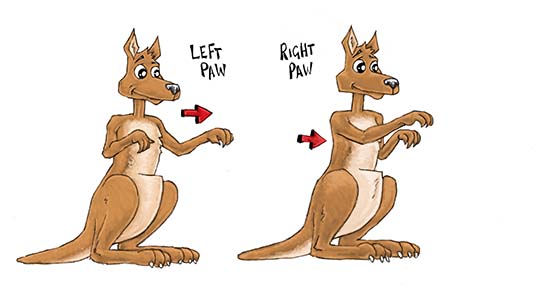
Step 1 The paws
The ears are a primary form of defence. Kangaroos have very acute hearing and can sense danger from the slightest noise. This reminds the hunter to be extremely quiet.
Action: Left-paw followed by right-paw to the beat of the music.
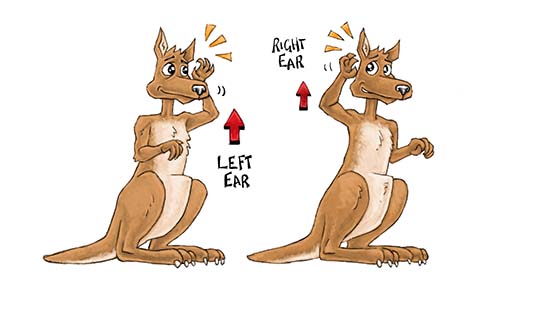
Step 2 The ears
The paws are used to grasp food and maintain balance whilst hopping. Large red kangaroos can achieve speeds of 70 kph, leap a distance of 8 m and clear fences up to 3 m. They can easily evade the hunter, once sensed. The following steps depict how the kangaroo can sense a predator. If this information is understood the hunter has a greater chance of success in the hunt.
Action: Left-ear followed by Right-ear.
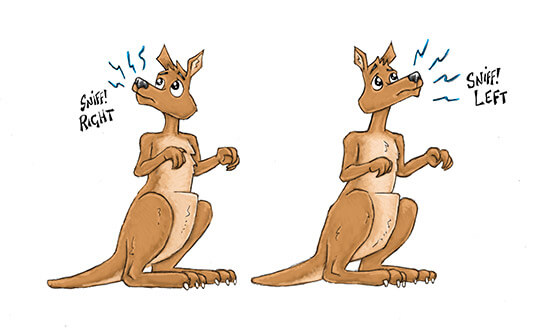
Step 3. The nose
Kangaroos have an excellent sense of smell. They can smell danger in the form of predators in minute amount carried by the wind. Hunters need to approach the kangaroo from the down wind direction. This reminds the hunter to approach mobs of kangaroos from down wind.
Action: Upwardly sniff the air left-side followed by sniff the air right-side.

Step 4. The hop forward
An interesting fact is that a kangaroo cannot hop backwards. This action reminds dancers that the kangaroo cannot move backwards to escape, so approach from the front.
Action: On the drawn out ‘Heeeeyyyyy’ the dancer moves in time with the music to a squat position. On the word ‘Kangarena’ the dancer hops forward.
Kangarena around the world
| Country | City/Town | Date | Reformers People/Group |
Link |
|---|---|---|---|---|
| Mallorca, Spain | Pòrtol, Marratxi | 23rd May 2017 | APABAL (English teachers group) | Kangarena performance 1 |
| Mallorca, Spain | Pòrtol, Marratxi | 23rd May 2017 | APABAL (English teachers group) | Kangarena performance 2 |
| Australia | Durba Springs | 23rd July 2018 | Glenyse, Marcia, Roo | Kangarena performance 3 |
| England | Trafalgar Square | 30th October 2018 | Roo | Kangarena performance 4 |
| Spain | Madrid | 27th May 2019 | Roo | Kangarena performance 5 |
| Spain | Valencia | 29th May 2019 | Roo | Kangarena performance 6 |
| Ibiza, Spain | Eivissa | 31st May 2019 | Roo | Kangarena performance 7 |
| Mallorca, Spain | Sant Elm | 5th June 2019 | Aina, Roo | Kangarena performance 8 |
| Provence, France | Menerbes | 9th June 2019 | Roo | Kangarena performance 9 |
| France | Marseille | 11th June 2019 | Roo | Kangarena performance 10 |
| France | Avignon | 14th June 2019 | Roo | Kangarena performance 11 |
| Flanders, France | Morbecque | 20th June 2019 | Francois, Lucie, Roo | Kangarena performance 12 |
| Somerset, England | Cheddar Gorge | 26th June 2019 | Roo | Kangarena performance 13 |
| South Australia | Barossa Valley | 18th September 2019 | Roo | Kangarena performance 14 |
| Victoria, Australia | Mitta Mitta | 23rd November 2019 | Roo | Kangarena performance 15 |
| Tivua Island, Fiji | Tivua Island | 6th February 2020 | Roo | Kangarena performance 16 | Braeside Park, Victoria | Braeside Victoria | 10th August 2020 | Roo | Kangarena performance 17 | Rottnest Island, Western Australia | Rottnest Island, Western Australia | 1st January 2021 | Roo | Kangarena performance 18 | NSW, Australia | Parkes Radio Telescope | 22nd August 2022 | Roo | Kangarena performance 19 | Queensland, Australia | Tropic of Capricorn, Rockhampton | 27th August 2022 | Roo | Kangarena performance 20 | Queensland, Australia | Bloomfield Falls, Daintree Rainforrest | 11th September 2022 | Roo | Kangarena performance 21 | Queensland, Australia | Weipa, Gulf of Carpentaria | 15th September 2022 | Roo, Kay & Ellen | Kangarena performance 22 | Queensland, Australia | Pajinka; the northenmost tip of the Australian mainland | 18th September 2022 | Roo, Kay & Ellen | Kangarena performance 23 | Torres Straight Islands, Australia | Thursday Island Township, TI | 19th September 2022 | Roo | Kangarena performance 24 | Queensland, Australia | Great Barrier Reef, Cairns | 8th September 2022 | Roo | Kangarena performance 25 | Tasmania, Australia | Salamanca Market, Hobart | 12th November 2022 | Roo | Kangarena performance 26 | Tasmania, Australia | Beauty Point, Tamar Valley | 22nd November 2022 | Roo | Kangarena performance 27 | ACT, Australia | Canberra | 2nd December 2022 | Roo | Kangarena performance 28 | Tokoriki Island, Fiji | Tokoriki Island Resort | 15th February 2023 | Roo | Kangarena performance 29 | Western Australia | Ardyaloon, Dampier Peninsula | 15th May 2023 | Roo | Kangarena performance 30 | Western Australia | Mitchell Falls, Kimberley | 21st May 2023 | Roo | Kangarena performance 31 | Western Australia | Emma Gorge, East Kimberley | 24th May 2023 | Roo | Kangarena performance 32 | Western Australia | Bungle Bungles | 27th May 2023 | Bernie, Marian, Mary-Ann, Roo, Ray, Ross & Paul | Kangarena performance 33 | Western Australia | Tunnel Creek, Western Kimberley | 29th May 2023 | Roo | Kangarena performance 34 | Western Australia | Horizontal Falls, Talbot Bay, Buccaneer Archipelago | 1st June 2023 | Roo | Kangarena performance 35 | Western Australia | Cable Beach, Broome | 2nd June 2023 | Roo | Kangarena performance 36 | Western Australia | Swan River, South of Perth | 4th June 2023 | Roo | Kangarena performance 37 | Western Australia | Cape Leeuwin | 8th June 2023 | Roo | Kangarena performance 38 | Western Australia | Elephant Rock, Demark | 13th June 2023 | Roo | Kangarena performance 39 | Victoria, Australia | Murray River, Echuca | 26th August 2023 | Roo | Kangarena performance 40 | Victoria, Australia | Aireys Inlet | 25th February 2024 | Roo | Kangarena performance 41 | Victoria, Australia | Lake Nagambie | 3rd March 2024 | Roo | Kangarena performance 42 | California, USA | Griffith Obervatory, Hollywood Hills, LA | 25th April 2024 | Roo | Kangarena performance 43 | Illinois, USA | Lake Michigan Chicago | 27th April 2024 | Roo | Kangarena performance 44 | Arizona, USA | Antelope Canyon | 30th May 2024 | Roo | Kangarena performance 46 | Arizona, USA | Horseshoe Bend, Colorado River | 30th May 2024 | Roo | Kangarena performance 47 | Illinois, USA | Route 66 Start, Chicago | 1st May 2024 | Roo | Kangarena performance 48 | Illinois, USA | Route 66 Joliet. Blues Brothers Tribute | 3rd May 2024 | Roo | Kangarena performance 49 | New Mexico, USA | Route 66, Continental Divide | 11th May 2024 | Roo & his International Bikie Mates | Kangarena performance 52 | Arizona, USA | Route 66, Winslow Arizona Eagles Tribute | 11th May 2024 | Roo & "The Girl" | Kangarena performance 53 | Arizona, USA | Route 66, Meteor Crater | 12th May 2024 | Roo | Kangarena performance 54 | Arizona, USA | Route 66, Oatman | 13th May 2024 | Roo | Kangarena performance 55 | Utah, USA | Bryce Canyon | 27th May 2024 | Sue, Rick, Denise, Arthur, Roo, Deanna, Ellis, John & Judy | Kangarena performance 66 | NSW | Mirrool | 18th August 2024 | Roo | Kangarena performance 68 | NSW | Lachlan River Art Trail | 20th August 2024 | Roo | Kangarena performance 69 | Queensland | Glass House Mountains | 28th August 2024 | Roo | Kangarena performance 70 | Queensland | Carlo Sand Blow, Rainbow Beach | 6th September 2024 | Roo | Kangarena performance 71 | NSW | The Three Sisters, Blue Mountains | 20th September 2024 | Roo | Kangarena performance 72 | South Sea Island | Off the Fiji Coast | 8th February 2025 | Don & Fierce Fiji Warriors | Kangarena performance 73 |
FAQ
Q. Is the kangaroo able to hop backwards?
A. No, this is a real fact.
Please submit your feedback about the site and your questions.
Forward questions and feedback to [email protected]
* This is material is based on both fictional and factual information. The website owners will leave it to the reader to decide what is fact and what is alternative fact. In these challenging times it is often difficult to distinguish between the two, so we encourage you to make the effort. If you do it is likely that you will be in the minority of the population.
* None of this material is designed to cause offense to any culture or person. It is presented with a good dose of Australian larrikinism. Participate, contribute and enjoy!